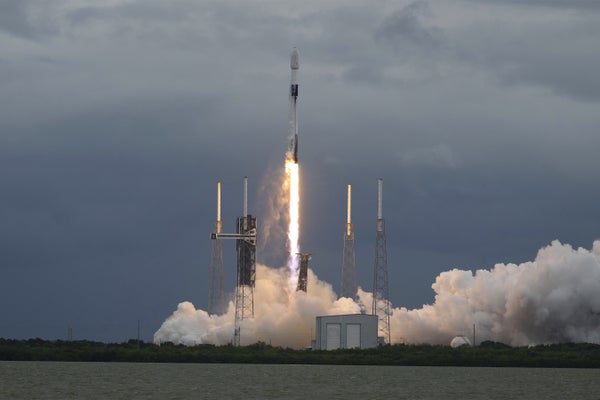October 8, 2024
3 min read
Europe’s Hera Mission Launches to Visit an Asteroid Smacked by NASA
Hera will arrive in 2026 at Dimorphos, an asteroid deliberately struck by NASA’s DART spacecraft
ESA’s Hera mission lifted off on a SpaceX Falcon 9 from Cape Canaveral Space Force Station in Florida, USA, on 7 October at 10:52 local time.
A unique asteroid mission is underway.
The European Space Agency’s Hera mission launched today (Oct. 7) at 10:52 a.m. EDT (1452 GMT), riding a SpaceX Falcon 9 rocket from Cape Canaveral Space Force Station in coastal Florida.
ESA’s Hera spacecraft soared into a cloudy sky above Florida to begin a multimillion-mile trek across the solar system to the binary asteroid system Didymos, which became famous in September 2022 after NASA smacked its DART (Double Asteroid Redirect Mission) into Didymos’ smaller companion, Dimorphos. That impact altered the orbit of Dimorphos, demonstrating the utility of a planetary defense strategy that could help keep Earth safe from rogue asteroids in the future. Hera will follow up on the DART mission to check on its aftermath.
On supporting science journalism
If you’re enjoying this article, consider supporting our award-winning journalism by subscribing. By purchasing a subscription you are helping to ensure the future of impactful stories about the discoveries and ideas shaping our world today.
“We want to see that acquisition of signal at the end where Here calls home and says, ‘It’s okay, I’m on my way to Dimorphous,” said astronomer Alan Fitzsimmons, a Hera science team board member, said before launch in a live webcast. Hera successfully separated from the upper stage of its Falcon 9 rocket about 1 hour and 16 minutes after liftoff, and successfully phoned home for its signal acquisition, ESA officials said.
The news was a relief for Fitzsimmons and the entire Hera team.
“We’ve got a working spacecraft,” Fitzsimmons added. “We’re now going back to Didymos and Dimorphos, we’ll make those measurements and we’ll make the world a safer place from the impact of asteroids.”
Hera’s launch went ahead after SpaceX received authorization from the U.S. Federal Aviation Administration (FAA) to resume flights after an anomaly last week.
Unlike typical SpaceX launches, the Falcon 9 first stage did not return to Earth for a smooth landing. In order to launch Hera on its asteroid mission, SpaceX had to use all the fuel on the Falcon 9 booster for the launch. This was the 23rd flight of the Falcon 9 booster, called Booster 1061, which previously launched 10 Starlink missions for SpaceX, two Transporter rideshare flights, two NASA astronaut flights, a NASA cargo flight and seven other satellite and space missions.
“Farewell, 1061, and we thank you,” SpaceX’s John Insprucker, principal integration engineer, said to the booster after stage separation.
During an otherwise nominal Falcon 9 launch of two astronauts toward the International Space Station on Sept. 28, the rocket’s upper stage had an “off-nominal deorbit burn,” which resulted in the stage coming down in the ocean outside of its target disposal area, SpaceX stated. (The upper stage of the Falcon 9 is not reusable, unlike the first stage, which lands autonomously minutes after going to space.)
The $398 million (363 million Euro) Hera spacecraft, accompanied by two smaller cubesats called named Milani and Juventas, is scheduled to arrive at Dimorphos in late 2026 to look at DART’s work up close. On the way, Hera will swing by Mars in 2025 to nab a gravity assist for its asteroid trip.
The NASA mission shortened Dimorphos’ orbit by 33 minutes and may have changed the shape of the little moon as well.
Hera will look at the depth and size of the crater that DART gouged out on Dimorphos and confirm the impact’s changes on the moon, if any, against early simulations.
The two cubesats, meanwhile, will examine the structure of Dimorphos along with its surface minerals and gravity, all of which will help to refine models.
“Planetary defense is an inherently international endeavour, and I am really happy to see ESA’s Hera spacecraft at the forefront of Europe’s efforts to help protect Earth,” ESA Director General Josef Aschbacher said in a statement after launch. “Hera is a bold step in scaling up ESA’s engagement in planetary defence.”
Copyright 2024 Space.com, a Future company. All rights reserved. This material may not be published, broadcast, rewritten or redistributed.

